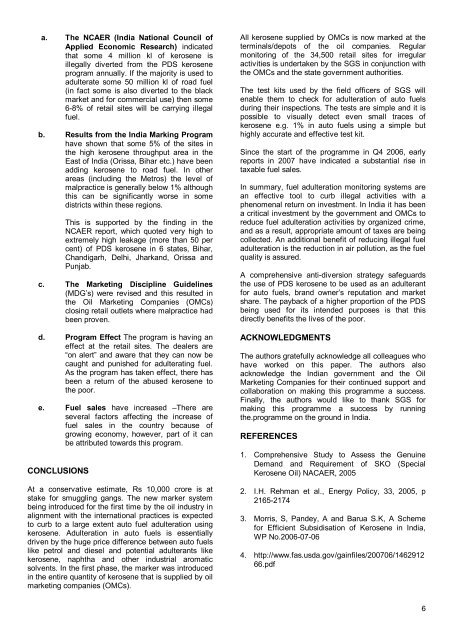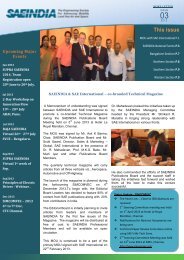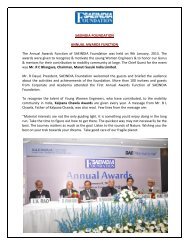The Kerosene Marking Programme In India - SAEINDIA
The Kerosene Marking Programme In India - SAEINDIA
The Kerosene Marking Programme In India - SAEINDIA
You also want an ePaper? Increase the reach of your titles
YUMPU automatically turns print PDFs into web optimized ePapers that Google loves.
a. <strong>The</strong> NCAER (<strong>In</strong>dia National Council of<br />
Applied Economic Research) indicated<br />
that some 4 million kl of kerosene is<br />
illegally diverted from the PDS kerosene<br />
program annually. If the majority is used to<br />
adulterate some 50 million kl of road fuel<br />
(in fact some is also diverted to the black<br />
market and for commercial use) then some<br />
68% of retail sites will be carrying illegal<br />
fuel.<br />
b. Results from the <strong>In</strong>dia <strong>Marking</strong> Program<br />
have shown that some 5% of the sites in<br />
the high kerosene throughput area in the<br />
East of <strong>In</strong>dia (Orissa, Bihar etc.) have been<br />
adding kerosene to road fuel. <strong>In</strong> other<br />
areas (including the Metros) the level of<br />
malpractice is generally below 1% although<br />
this can be significantly worse in some<br />
districts within these regions.<br />
This is supported by the finding in the<br />
NCAER report, which quoted very high to<br />
extremely high leakage (more than 50 per<br />
cent) of PDS kerosene in 6 states, Bihar,<br />
Chandigarh, Delhi, Jharkand, Orissa and<br />
Punjab.<br />
c. <strong>The</strong> Marketing Discipline Guidelines<br />
(MDG’s) were revised and this resulted in<br />
the Oil Marketing Companies (OMCs)<br />
closing retail outlets where malpractice had<br />
been proven.<br />
d. Program Effect <strong>The</strong> program is having an<br />
effect at the retail sites. <strong>The</strong> dealers are<br />
“on alert” and aware that they can now be<br />
caught and punished for adulterating fuel.<br />
As the program has taken effect, there has<br />
been a return of the abused kerosene to<br />
the poor.<br />
e. Fuel sales have increased –<strong>The</strong>re are<br />
several factors affecting the increase of<br />
fuel sales in the country because of<br />
growing economy, however, part of it can<br />
be attributed towards this program.<br />
CONCLUSIONS<br />
At a conservative estimate, Rs 10,000 crore is at<br />
stake for smuggling gangs. <strong>The</strong> new marker system<br />
being introduced for the first time by the oil industry in<br />
alignment with the international practices is expected<br />
to curb to a large extent auto fuel adulteration using<br />
kerosene. Adulteration in auto fuels is essentially<br />
driven by the huge price difference between auto fuels<br />
like petrol and diesel and potential adulterants like<br />
kerosene, naphtha and other industrial aromatic<br />
solvents. <strong>In</strong> the first phase, the marker was introduced<br />
in the entire quantity of kerosene that is supplied by oil<br />
marketing companies (OMCs).<br />
All kerosene supplied by OMCs is now marked at the<br />
terminals/depots of the oil companies. Regular<br />
monitoring of the 34,500 retail sites for irregular<br />
activities is undertaken by the SGS in conjunction with<br />
the OMCs and the state government authorities.<br />
<strong>The</strong> test kits used by the field officers of SGS will<br />
enable them to check for adulteration of auto fuels<br />
during their inspections. <strong>The</strong> tests are simple and it is<br />
possible to visually detect even small traces of<br />
kerosene e.g. 1% in auto fuels using a simple but<br />
highly accurate and effective test kit.<br />
Since the start of the programme in Q4 2006, early<br />
reports in 2007 have indicated a substantial rise in<br />
taxable fuel sales.<br />
<strong>In</strong> summary, fuel adulteration monitoring systems are<br />
an effective tool to curb illegal activities with a<br />
phenomenal return on investment. <strong>In</strong> <strong>In</strong>dia it has been<br />
a critical investment by the government and OMCs to<br />
reduce fuel adulteration activities by organized crime,<br />
and as a result, appropriate amount of taxes are being<br />
collected. An additional benefit of reducing illegal fuel<br />
adulteration is the reduction in air pollution, as the fuel<br />
quality is assured.<br />
A comprehensive antidiversion strategy safeguards<br />
the use of PDS kerosene to be used as an adulterant<br />
for auto fuels, brand owner’s reputation and market<br />
share. <strong>The</strong> payback of a higher proportion of the PDS<br />
being used for its intended purposes is that this<br />
directly benefits the lives of the poor.<br />
ACKNOWLEDGMENTS<br />
<strong>The</strong> authors gratefully acknowledge all colleagues who<br />
have worked on this paper. <strong>The</strong> authors also<br />
acknowledge the <strong>In</strong>dian government and the Oil<br />
Marketing Companies for their continued support and<br />
collaboration on making this programme a success.<br />
Finally, the authors would like to thank SGS for<br />
making this programme a success by running<br />
the.programme on the ground in <strong>In</strong>dia.<br />
REFERENCES<br />
1. Comprehensive Study to Assess the Genuine<br />
Demand and Requirement of SKO (Special<br />
<strong>Kerosene</strong> Oil) NACAER, 2005<br />
2. I.H. Rehman et al., Energy Policy, 33, 2005, p<br />
21652174<br />
3. Morris, S, Pandey, A and Barua S.K, A Scheme<br />
for Efficient Subsidisation of <strong>Kerosene</strong> in <strong>In</strong>dia,<br />
WP No.20060706<br />
4. http://www.fas.usda.gov/gainfiles/200706/1462912<br />
66.pdf<br />
6







